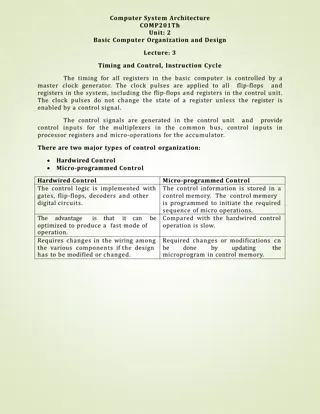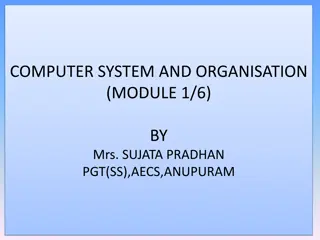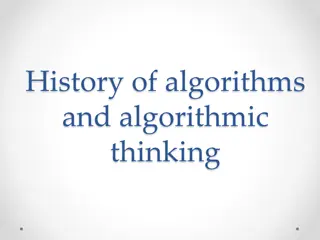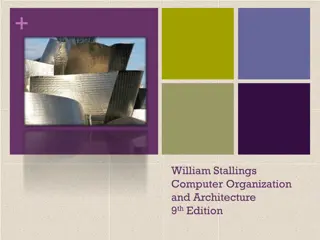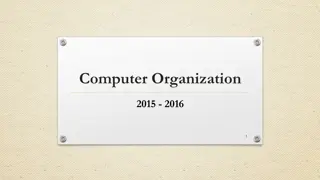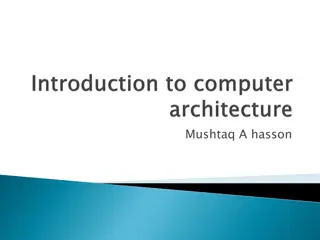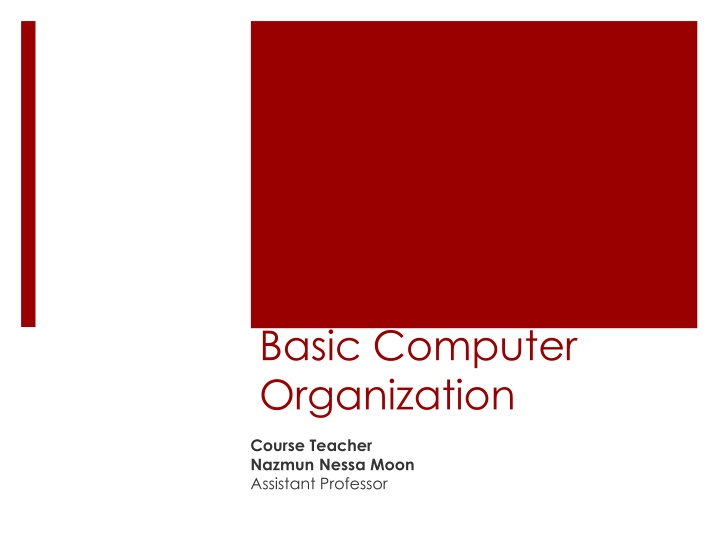
Basic Computer Organization and Operations
Explore the fundamentals of computer organization including input, output, and storage units, along with the five basic operations performed by computer systems. Learn about the roles of ALU, CU, and CPU in processing data and instructions effectively.
Download Presentation

Please find below an Image/Link to download the presentation.
The content on the website is provided AS IS for your information and personal use only. It may not be sold, licensed, or shared on other websites without obtaining consent from the author. If you encounter any issues during the download, it is possible that the publisher has removed the file from their server.
You are allowed to download the files provided on this website for personal or commercial use, subject to the condition that they are used lawfully. All files are the property of their respective owners.
The content on the website is provided AS IS for your information and personal use only. It may not be sold, licensed, or shared on other websites without obtaining consent from the author.
E N D
Presentation Transcript
Basic Computer Organization Course Teacher Nazmun Nessa Moon Assistant Professor
Learning Objectives In this lecture you will learn about: Basic operations performed by all types of computer systems Basic organization of a computer system Input unit and its functions Output unit and its functions Storage unit and its functions Types of storage used in a computer system Arithmetic Logic Unit (ALU) Control Unit (CU) Central Processing Unit (CPU) Computer as a system
The Five Basic Operations of a Computer System Inputting. The process of entering data and instructions into the computer system Storing. Saving data and instructions to make them readily available for initial or additional processing whenever required Processing. Performing arithmetic operations (add, subtract, multiply, divide, etc.) or logical operations (comparisons like equal to, less than, greater than, etc.) on data to convert them into useful information Outputting. The process of producing useful information or results for the user such as a printed report or visual display Controlling. Directing the manner and sequence in which all of the above operations are performed
Input Unit An input unit of a computer system performs the following functions: It accepts (or reads) instructions and data from outside world It converts these instructions and data in computer acceptable form It supplies the converted instructions and data to the computer system for further processing
Output Unit An output unit of a computer system performs the following functions: It accepts the results produced by the computer, which are in coded form and hence, cannot be easily understood by us It converts these coded results to human acceptable (readable) form It supplies the converted results to outside world
Storage Unit The storage unit of a computer system holds (or stores) the following : Data and instructions required for processing (received from input devices) Intermediate results of processing Final results of processing, before they are released to an output device
Two Types of Storage Primary storage Used to hold running program instructions Used to hold data, intermediate results, and results of ongoing processing of job(s) Fast in operation Small Capacity Expensive Volatile (looses data on power dissipation)
Two Types of Storage Secondary storage Used to hold stored program instructions Used to hold data and information of stored jobs Slower than primary storage Large Capacity Lot cheaper than primary storage Retains data even without power
Arithmetic Logic Unit (ALU) Arithmetic Logic Unit of a computer system is the place where the actual executions of instructions takes place during processing operation
Control Unit (CU) Control Unit of a computer system manages and coordinates the operations of all other components of the computer system The control unit is a component of a computer's central processing unit (CPU) that directs operation of the processor. It controls communication and co-ordination between input/output devices. It reads and interprets instructions and determines the sequence for processing the data. It directs the operation of the other units by providing timing and control signals. All computer resources are managed by the CU (Control Unit). It directs the flow of data between the Central Processing Unit (CPU) and the other devices.
Central Processing Unit (CPU) It is the brain of a computer system It is responsible for controlling the operations of all other units of a computer system
The System Concept A system has following three characteristics: A system has more than one element All elements of a system are logically related All elements of a system are controlled in a manner to achieve the system goal A computer is a system as it comprises of integrated components (input unit, output unit, storage unit, and CPU) that work together to perform the steps called for in the executing program
Key Words/Phrases Arithmetic Logic Unit (ALU) Controlling Output interface Secondary storage Auxiliary storage Input interface Output unit Storage unit Central Processing Unit (CPU) Input unit Outputting Storing Computer system Inputting Primate storage System Control Unit (CU) Main memory Processing





